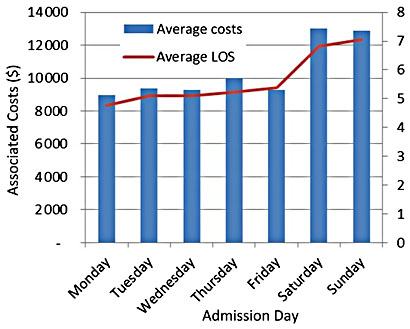A couple of months ago I blogged about a study showing that your odds of dying after elective surgery are a lot higher if the surgery is done on a Friday or a weekend. Most likely, this is due to lower staffing levels during the 48 hours after surgery, which is when most complications set in. The moral of the story was pretty simple: if you have a choice, get your surgery done between Monday and Thursday.
Today brings further evidence of the folly of going to the hospital on the weekend. This one comes courtesy of Aaron Carroll, who points us to a study of infants admitted to pediatric hospitals with a diagnosis of failure to thrive. Basically, this means that the baby isn’t gaining weight as quickly as normal, or is even losing weight, and I gather from  Aaron’s post that it’s rarely an emergency situation. However, it involves lots of tests and consults, and those tests and consults often aren’t available on weekends. As a result, nothing happens until all the doctors and technicians return to work on Monday.
Aaron’s post that it’s rarely an emergency situation. However, it involves lots of tests and consults, and those tests and consults often aren’t available on weekends. As a result, nothing happens until all the doctors and technicians return to work on Monday.
The chart on the right shows how this works out. If your baby is admitted on a weekday, the average length of stay is five days and the average cost is about $9,000. But if your baby is admitted on a weekend, the average length of stay is seven days and the average cost is about $13,000. For all practical purposes, it looks like the babies just sit around over the weekend and then start getting treated on Monday.
Obviously you don’t always have a choice of what day you go to the hospital. But if you do, don’t go on a weekend. Stick to weekdays, when there are actually doctors around to treat you.

















